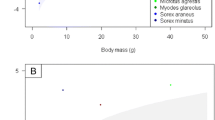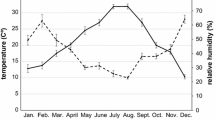Abstract
Infestation by Ixodes ricinus ticks on rodents, hares and cervids was examined at Bogesund, 10 km north of Stockholm, in south-central Sweden during 1991-1994 and on varying hares (Lepus timidus) at Stora Karlso and Gotska Sandon in the Baltic Sea during 1992-1993. At Bogesund, there were great differences between two consecutive years in the number of I. ricinus larvae infesting bank voles (Clethrionomys glareolus). The seasonal pattern of infestation by I. ricinus larvae and nymphs on bank voles was unimodal in 1991, with peaks in June-July and bimodal in 1992, with peaks in June and August. Male bank voles, compared to females and older voles, compared to young voles, harboured greater numbers of I. ricinus ticks. Apodemus mice, compared to bank voles, harboured greater numbers of I. ricinus ticks. Ixodes ricinus larvae engorged on Apodemus mice were heavier than larvae engorged on bank voles and resulted in larger nymphs. However, there was no difference in the proportions of viable nymphs resulting from larvae engorged on mice or voles. The ranges in the numbers of I. ricinus ticks infesting individual hosts were 1-451 for rodents, 16-2374 for hares and 428-2072 for roe deer (Capreolus capreolus). These ranges of tick numbers are estimated to represent potential blood losses from individual hosts of approximately 0.2-65% for rodents, 0.2-13% for hares and 0.3-9.0% for roe deer. Within the populations of all host species examined, the distributions of all stages of I. ricinus were clumped, with most host individuals harbouring few ticks and only a few individuals harbouring many ticks. The data suggest that, even though a small proportion of tick hosts may be severely affected, the direct effects of feeding by I. ricinus are unlikely to play an important role on mammal population dynamics.
Similar content being viewed by others
REFERENCES
Balashov, Yu.S. 1972. [Bloodsucking ticks (Ixodoidea) — vectors of diseases of man and animals]. Misc. Publ. Entomol. Soc. Am. 8: 163–176 (English translation).
Bauwens, D., Strijbosch, H. and Stumpel, A.H.P. 1983. The lizards Lacerta agilis and L. vivipara as hosts to larvae and nymphs of the tick Ixodes ricinus. Holarctic Ecol. 6: 32–40.
Bolte, J.R., Hair, J.A. and Fletcher, J. 1970. White-tailed deer mortality following tissue destruction induced by lone star ticks. J. Wildl. Manage., 34: 546–552.
Bondrup-Nielsen, S. and Karlsson, F. 1985. Movements and spatial patterns in populations of Clethrionomys species: a review. Ann. Zool. Fenn. 22: 385–392.
Brinck, P., Johnels, A., Lundholm, B., von Zeipel, G. and Zetterberg, B. 1967. Small mammals as hosts of tick-borne encephalitis virus and vagrant ectoparasites. Oikos 18: 124–134.
Brinck, P., Brinck-Lindroth, G., Edler, A., Lundqvist, L. and Nilsson, A. 1984. Ectoparasites (Insecta: Anoplura and Siphonaptera. Acari: Mesostigmata, Ixodoidea) on small mammals in Draved forest, Denmark. Entomol. Medd. 51: 103–11.
Brunet, L.R., Sellitto, C., Spielman, A. and Telford, S.R., III 1995. Antibody response of the mouse reservoir of Borrelia burgdorferi in nature. Infect. Immunol. 63: 3030–3036.
Bull, C.M. and Burzacott, D. 1993. The impact of tick load on the fitness of their lizard hosts. Oecologia 96: 415–419.
Craine, N.G., Randolph, S.E. and Nuttall, P.A. 1995. Seasonal variation in the role of grey squirrels as hosts of Ixodes ricinus, the tick vector of the Lyme disease spirochete, in a British woodland. Folia Parasitol. 42: 73–80.
de Boer, R., Hovius, K.E., Nohlmans, M.K.E. and Gray, J.S. 1993. The woodmouse (Apodemus sylvaticus) as a reservoir of tick-transmitted spirochetes (Borrelia burgdorferi) in The Netherlands. Zentralbl. Bakteriol. Mikrobiol. Hyg. Ser. A279: 404–416.
Dizij, A. and Kurtenbach, K. 1995. Clethrionomys glareolus, but not Apodemus flavicollis, acquires resistance to Ixodes ricinus L., the main European vector of Borrelia burgdorferi. Parasite Immunol. 17: 177–183.
Doby, J.M., Bigaignon, G. and Degeilh, B. 1992. Importance potentielle comparée du mulot gris (Apodemus sylvaticus) et du campagnol roussâtre (Clethrionomys glareolus) dans l'ouest de la France, au travers de la relation rongeuers — Ixodes ricinus. Bull. Soc. Franç. Parasitol. 10: 271–293.
Erlinge, S., Hoogenboom, I., Agrell, J., Nelson, J. and Sandell, M. 1990. Density-related home-range size and overlap in adult field voles (Microtus agrestis) in southern Sweden. J. Mammal. 71: 597–603.
Gemmell, R.T., Cepon, G., Green, P.E. and Stewart, N.P. 1991. Some effects of tick infestation on juvenile northern brown bandicoot (Isodon macrourus). J. Wildl. Dis. 27: 269–275.
Gigon, F. 1985. Biologie d'Ixodes ricinus L. sur le Plateau Suisse — une contribution à l' écologie de ce vecteur. Thèse présentée à la Faculté des Sciences de l'Université de Neuchâtel.
Gray, J.S. 1984. Studies on the dynamics of active populations of the sheep tick, Ixodes ricinus L., in Co. Wicklow, Ireland. Acarologia 25: 167–178.
Gray, J.S., Turley, T. and Strickland, K.L. 1978. Studies on the ecology of sheep tick, Ixodes ricinus, in Co. Wicklow, Ireland. Irish Vet. J. February: 25–34.
Gray, J.S., Kahl, O., Janetzki, C. and Stein, J. 1992. Studies on the ecology of Lyme disease in a deer forest in County Galway, Ireland. J. Med. Entomol. 29: 915–920.
Gray, J.S., Kahl, O., Janetzki, C., Stein, J. and Guy, E. 1995. The spatial distribution of Borrelia burgdorferi-infected Ixodes ricinus in the Connemara region of County Galway, Ireland. Exp. Appl. Acarol. 19: 163–172.
Hair, J.A., Hoch, A.L., Buckner, R.G. and Baker, R.W. 1992. Fawn hematology and survival following tick infestation and theileriasis. J. Agricult. Entomol. 9: 301–319.
Humair, P.F., Turrian, N., Aeschlimann, A. and Gern, L. 1993. Borrelia burgdorferi in a focus of Lyme borreliosis: epizootiologic contribution of small mammals. Folia Parasitol. 40: 65–70.
Jaenson, T.G.T. and Tälleklint, L. 1996. Lyme borreliosis spirochetes in Ixodes ricinus (Acari: Ixodidae) and the varying hare on isolated islands in the Baltic Sea. J. Med. Entomol. 33: 339–343.
Jaenson, T.G.T., Tälleklint, L., Lundqvist, L., Olsen, B., Chirico, J. and Mejlon, H.A. 1994. Geographical distribution, host associations and vector roles of ticks (Acari: Ixodidae, Argasidae) in Sweden. J. Med. Entomol. 31: 240–256.
Kaufman, W.R. 1989. Tick-Host interaction: a synthesis of current concepts. Parasitol. Today 5: 47–56.
Keith, L.B. and Cary, J.R. 1990. Interaction of the tick (Haemaphysalis leporispalustris) with a cyclic snowshoe hare (Lepus americanus) population. J. Wildl. Dis. 26: 427–434.
Kitron, U., Jones, C.J. and Bouseman, J.K. 1991. Spatial and temporal dispersion of immature Ixodes dammini on Peromyscus leucopus in northwestern Illinois. J. Parasitol. 77: 945–949.
Kurtenbach, K., Kampen, H., Dizij, A., Arndt, S., Seitz, H.M., Schaible, U.E. and Simon, M.M. 1995. Infestation of rodents with larval Ixodes ricinus (Acari: Ixodidae) is an important factor in the transmission cycle of Borrelia burgdorferi s.l. in German woodlands. J. Med. Entomol. 32: 807–817.
Lebedeva, N.N. 1981. Differences between various species of Muridae in the feeding of larvae of ixodid ticks (Ixodidae). Parasitologia 15: 436–440.
Lehmann, T. 1993. Ectoparasites: direct impact on host fitness. Parasitol. Today 9: 8–13.
MacDonald, D. and Barret, P. 1993. Mammals of Britain and Europe. HarperCollins Publishers, London
Manelli, A., Kitron, U., Jones, C.J. and Slajchert, T.L. 1993. Role of the eastern chipmunk as a host for immature Ixodes dammini (Acari: Ixodidae) in northwestern Illinois. J. Med. Entomol. 30: 87–93.
Matuschka, F.R., Lange, R., Spielman, A., Richter, D. and Fischer, P. 1990. Subadult Ixodes ricinus (Acari: Ixodidae) on rodents in Berlin, West Germany. J. Med. Entomol. 27: 385–390.
Matuschka, F.R., Fischer, P., Musgrave, K., Richter, D. and Spielman, A. 1991. Hosts on which nymphal Ixodes ricinus most abundantly feed. Am. J. Trop. Med. Hygiene 4: 100–107.
Matuschka, F.R., Fischer, P., Heiler, M., Richter, D. and Spielman, A. 1992. Capacity of European animals as reservoir hosts for the Lyme disease spirochete. J. Infect. Dis. 165: 479–483.
Matuschka, F.R., Eiffert, H., Ohlenbusch, A. and Spielman, A. 1994. Amplifying role of edible dormice in Lyme disease transmission in central Europe. J. Infect. Dis. 170: 122–127.
Mermod, C., Aeschlimann, A. and Graf, J.-F. 1973. ‘Écologie et éthologie d’Ixodes ricinus Linné 1758 en Suisse (Acarina, Ixodoidea). Première note: fluctuations numériques. Acarologia 15: 197–205.
Mermod, C., Aeschlimann, A. and Graf, J.-F. 1974. Écologie et éthologie d'Ixodes ricinus L, en Suisse. Deuxième note: comparison des populations 1972 et 1973. Acarologia 16: 612–620.
Myllamäki. A. 1977. Intraspecific competition and home range dynamics in the field vole Microtus agrestis. Oikos 29: 553–569.
Nelson, W.A., Keirans, J.E., Bell, J.F. and Clifford, C.M. 1975. Host-Ectoparasite relationships. J. Med. Entomol. 12: 143–166.
Nelson, W.A., Keirans, J.E., Bell, J.F. and Clifford, C.M. 1977. Interactions of ectoparasites and their hosts. J. Med. Entomol. 13: 389–428.
Nilsson, A. 1988. Seasonal occurrence of Ixodes ricinus (Acari) in vegetation and on small mammals in southern Sweden. Holarctic Ecol. 11: 161–165.
Nilsson, A. and Lundqvist, L. 1978. Host selection and movements of Ixodes ricinus (Acari) on small mammals. Oikos 31: 313–322.
Pruszynska, I. 1983. Faunistic-ecological studies on the ectoparasites of the small mammals caught in the natural focus of tick-borne encephalitis in the region of Gdansk. Bull. Inst. Mar. Trop. Med. Gdynia 39: 91–107.
Randolph, S.E. 1977. Changing spatial relationships in a population of Apodemus sylvaticus with the onset of breeding. J. Animal Ecol. 46: 653–676.
Randolph, S.E. 1979. Population regulation in ticks: the role of acquired resistance in natural and unnatural hosts. Parasitology 79: 141–156.
Randolph, S.E. 1994. Density-dependent acquired resistance to ticks in natural hosts, independent of concurrent infection with Babesia microti. Parasitology 108: 413–419.
Randolph, S.E. and Steele, G.M. 1985. An experimental evaluation of conventional control measures against the sheep tick, Ixodes ricinus (L.) (Acari: Ixodidae). II. The dynamics of the tick-host interaction. Bull. Entomol. Res. 75: 501–518.
Rechav, Y. 1992. Naturally acquired resistance to ticks — a global view. Insect Sci. Appl. 13: 495–504.
Schmidt-Nielsen, K. 1975. Animal Physiology. Cambridge University Press, Cambridge.
Sokal, R.R. and Rohlf, F.J. 1981. Biometry. W. H. Freeman and Company, New York.
Sonenshine, D.E. 1993. Biology of Ticks, Vol. 2. Oxford University Press, Oxford.
Sonenshine, D.E. and Stout, J. 1968. Tick burdens in relation to spacing and range of hosts in Dermacentor variabilis. J. Med. Entomol. 5: 49–52.
Steele, G.M. and Randolph, S.E. 1985. An experimental evaluation of conventional control measures against the sheep tick, Ixodes ricinus (L.) (Acari: Ixodidae). I. A unimodal seasonal activity pattern. Bull. Entomol. Res. 75: 489–499.
Tälleklint, L. and Jaenson, T.G.T. 1994. Transmission of Borrelia burgdorferi. s. l. from mammal reservoirs to the primary vector of Lyme borreliosis, Ixodes ricinus (Acari: Ixodidae), in Sweden. J. Med. Entomol. 31: 880–886.
Tälleklint, L. and Jaenson, T.G.T. 1996. Seasonal variations in density of questing Ixodes ricinus (Acari: Ixodidae) nymphs and prevalence of infection with B. burgdorferi s.l. in south-central Sweden. J. Med. Entomol. 33: 592–597.
Viitala, J. and Hoffmeyer, I. 1985. Social organization in Clethrionomys compared with Microtus and Apodemus: social odours, chemistry and biological effects. Ann. Zool. Fenn. 22: 359–371.
Wikel, S.K. 1996. Host immunity to ticks. Ann. Rev. Entomol. 41: 1–22.
Ylönen, H. and Viitala, J. 1991. Social overwintering and food distribution in the bank vole Clethrionomys glareolus. Holarctic Ecol. 14: 131–137.
Author information
Authors and Affiliations
Rights and permissions
About this article
Cite this article
Talleklint, L., Jaenson, T.G. Infestation of mammals by Ixodes ricinus ticks (Acari: Ixodidae) in south-central Sweden. Exp Appl Acarol 21, 755–771 (1997). https://doi.org/10.1023/A:1018473122070
Issue Date:
DOI: https://doi.org/10.1023/A:1018473122070




